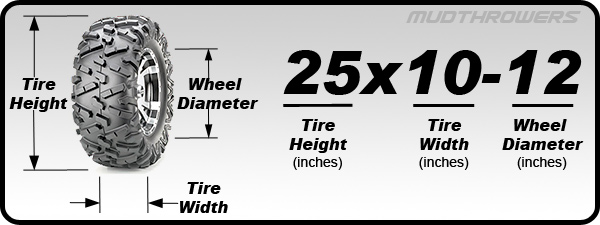When you purchase through links on our site, we may earn a commission at no additional cost to you. Learn More
When replacing the tires on your ATV, you must choose from a wide range of tire sizes. In this post, you’ll find information about the most common ATV tire sizes, a few real-life examples, how to read ATV tire sizes, and how you can be confident you choose the right size for your ATV.
ATV tire sizes are indicated on the tire sidewall and are typically given in one of two different sizing formats.
Out of the two, the imperial format in inches is most common in ATV tires. Metric sizing is more common in car tires, but now and then, you’ll stumble across an ATV tire with metric sizing.
ATV tire measurements are always with a tire that is inflated to the recommended tire pressure.
The easiest way to tell you’re dealing with a metric tire size is the dash “/” separating the first and second number rather than a hyphen “-“.
Another giveaway is the larger numbers. 100 millimeters equals 25.4 inches, so the numbers on a metric-sized tire are much higher than on a standard-sized tire.
The three numbers in the standard imperial tire sizing format represent three critical tire dimensions.
For example, a 26X11-14 size tire is 26 inches high and 11 inches wide and will mount to a wheel or rim that is 14 inches in diameter.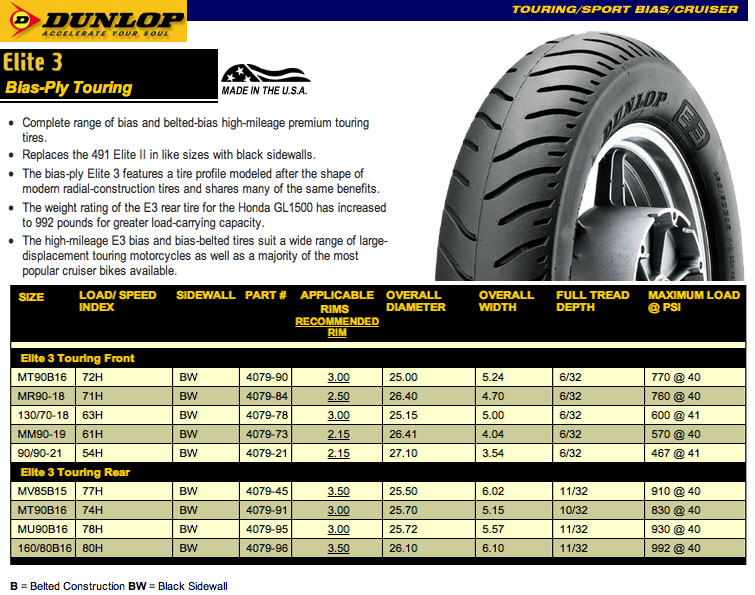
A Letter “R” between the second and third numbers indicates a radial construction tire, while a hyphen “-” indicates a bias ply tire.
The metric tire size format is not as self-explanatory as the standard imperial format. To make matters worse, it doesn’t only use millimeters but also inches, percentages, and letters.
Luckily you are much less likely to come across a metric-sized ATV tire. If you do, here is how to know what size it is.
For example, a 215/80-14 size tire is 215mm wide, has a sidewall height of 172mm (80% of 215mm), and will mount to a wheel or rim that is 14 inches in diameter.
A Letter “R” between the second and third numbers indicates a radial construction tire, while a hyphen “-” indicates a bias ply tire.
An average ATV tire is 25 to 27 inches tall and 7 to 10 inches wide, with a wheel diameter of 10 to 12 inches. Sport quad tires are usually slightly smaller than average, while mud tires are generally larger than standard tires.
In everyday speech, ATV tires are often referred to only by the tire’s outer diameter. Typical tires sizes can be categorized by ATV type :
Note that the front tires are usually one or two inches narrower than the rear tires.
Related: Why Do ATVs Have Smaller Front Tires? 9 Good Reasons
| ATV Brand and Model | Front Tire Size | Rear Tire Size |
| Polaris Sportsman 450 | 25X8-12 | 25X10-12 |
| Polaris Sportsman 1000 | 27X9-14 | 27X11-14 |
| Can-Am Outlander 450 / 570 (base model) | 25X9-12 | 25X11-12 |
| Can-Am Renegade 1000 | 25X8-12 | 25X11-12 |
| Can-Am Outlander 1000 | 26X8-12 | 26X10-12 |
| Honda Fourtrax Foreman 520 | 25X8-12 | 25X10-12 |
| Yamaha Grizzly 700 | 27X10-14 | 27X10-14 |
 Examples by model.
Examples by model.Youth ATVs are smaller in size and power than adult models, so their tires also need to be smaller.
A typical youth-sized ATV tire is between 18 to 21 inches tall and 7 to 10 inches wide, with a wheel diameter of 8 to 10 inches.
| ATV Brand and Model | Front Tire Size | Rear Tire Size |
| Can-Am Renegade 110 | 19X7-8 | 19X9,5-8 |
| Honda TRX 90 | 20X7-8 | 19X8-8 |
| Honda TRX 250 | 22X7-10 | 22X10-9 |
| Yamaha YFM 90 | 18X7-8 | 18X9-8 |
At a glance, most ATV tires look the same. But when you go to a tire shop in real life or online, you soon realize there are almost endless sizes to choose from. But why does it have to be this way? Why don’t all ATVs use the same size tire?
The wide range of available ATV tire sizes reflects the versatility ATVs are well-known for and the wide range of conditions they go in.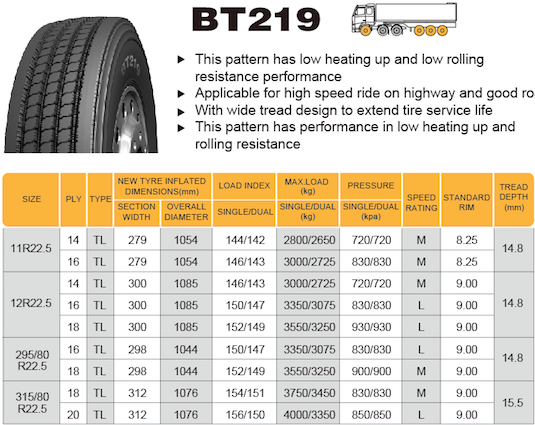
Different riding applications and riding conditions require different tire sizes for optimal performance.
For instance, when riding in soft and muddy conditions, you need a larger tire so you won’t sink in as much.
However, bigger tires are generally much heavier than smaller ones, negatively impacting acceleration and handling. That is why race quads typically use smaller tires.
ATV race tracks usually have medium to firm surfaces of dirt or gravel that don’t require massive tires not to get stuck. Winning the race requires a lightweight tire that spins easily so that as much as possible of the engine power gets converted into speed.
And finally, for most ATV riders, including those that use the bike for utility tasks, trail riding, or hunting, it’s all about finding a happy medium. That is why most ATV tires are from 25 to 27 inches tall.
Related: Will Bigger Tires Make an ATV Faster? (Or Slower?)
You cannot choose any size tire and expect good results.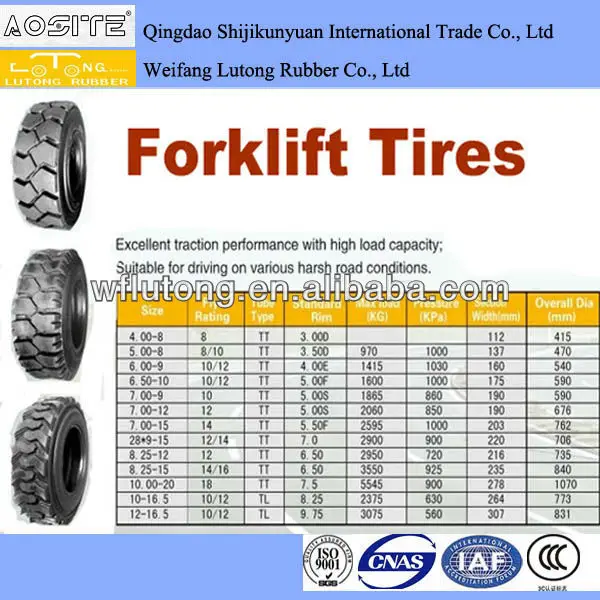
Your best bet would be to choose the same size as printed on the sidewall of your old ones.
Make sure to cross-reference the numbers against those specified in the user manual to ensure nobody has previously changed to a different-size tire.
You can measure and compare to ensure your chosen tire fits the wheel/rim.
Alot of people wonder whether they can install bigger tires on their ATVs. There are several reasons why people want to upgrade to beefier tires:
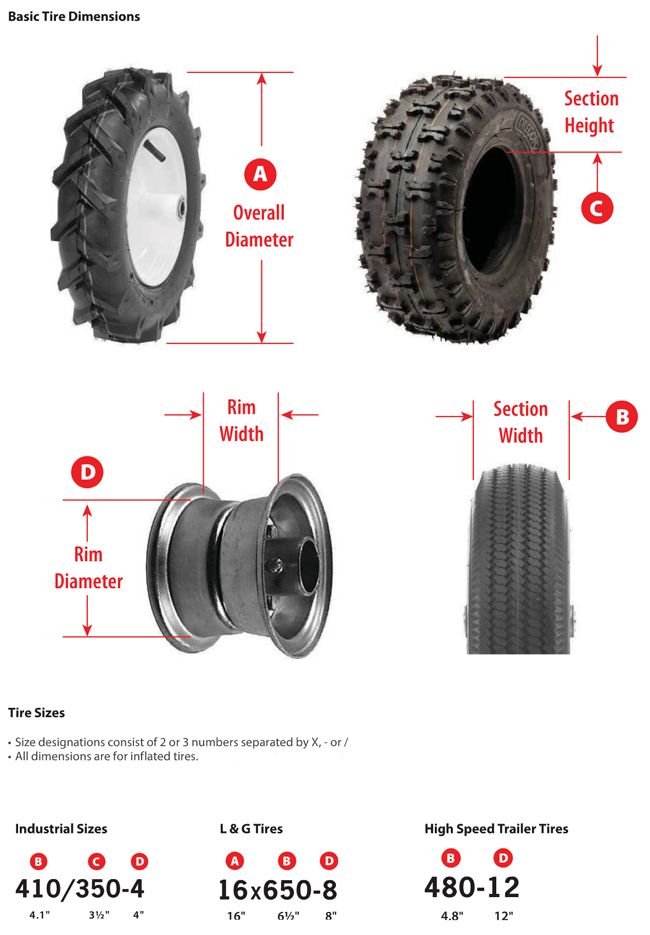
Generally, you can install one to two inches larger diameter tires without modifying the ATV. Larger tires require various modifications to prevent tire rubbing, gear ratio issues, loss of torque, and premature belt wear.
Please refer to this post if you want to learn more about things to consider when installing bigger tires.
Related: Are All ATV Tires Directional? How to Tell?
Tires hold great importance whenever we talk about ATVs. ATV tires are available in various sizes, shapes, treads, and materials. It cannot be easy to go through all the options to find the right tire for your riding style. Choosing the right tire for your environment improves handling, cornering, and braking depending on the riding terrain.
Basic Off-Roading Trivia
Please enable JavaScript
Basic Off-Roading Trivia
Changing tires when needed also improves performance, and the difference between used and new tires is immediately noticeable.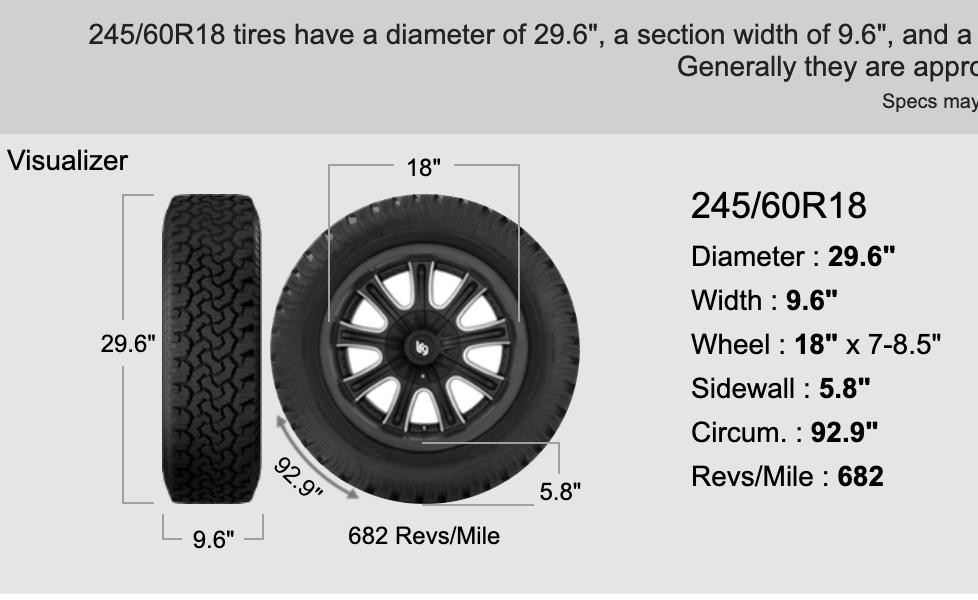 It’s worth the extra money for a high-end set of tires, but you don’t have to spend a lot of money to get a good tire that will last you years of driving. How to read ATV tire size?
It’s worth the extra money for a high-end set of tires, but you don’t have to spend a lot of money to get a good tire that will last you years of driving. How to read ATV tire size?
Reading an ATV tire size is not an arduous task. It requires some specific things which need to be considered. The inch is the most widely used unit of measurement for ATV tires. In the format 25 × 8.0012, the meaning of the number is:
For Example, AT25 × 812

So, in this example, the tire will be mounted on a 12″ wheel/rim, and its shape or shape cannot fit any other wheel size
Reading an ATV Tire Size:Firstly, make sure that you deal with standard or metric ATV tire sizes.
ATV Tire Size: Standard Tire Size Table:The standard format is much more common on ATV tires than metric. You can see the tire size is 26×1012 or 26x10x12. This format is very simple. Three numbers are used to sum the sizes.
| Height | The overall height of the tire when mounted and inflated to recommended air pressure.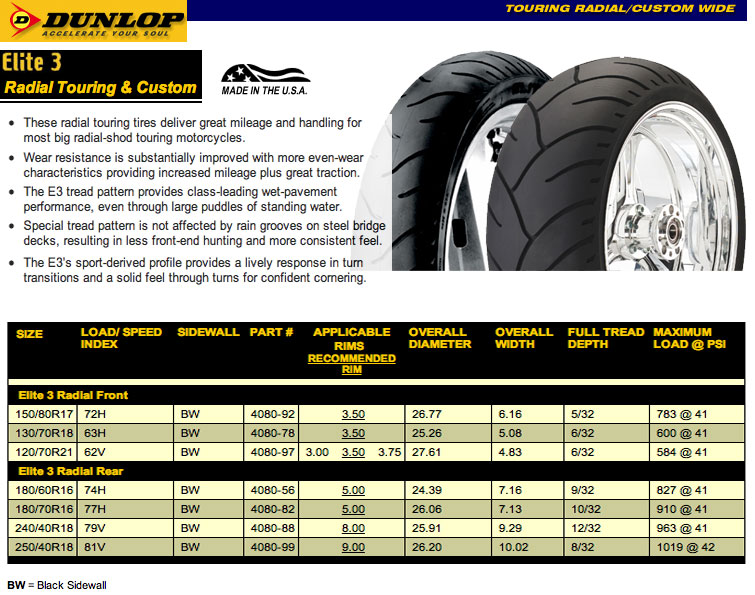 |
| Width | The overall width of the tire when mounted and inflated to recommended air pressure. |
| Diameter of the wheel | The diameter of the wheel that this tire will mount to. |
The metric format is extremely rare for ATVs, and you will rarely encounter it. But if you do, any letter thrown between those numbers will be a worthless sale. Metric always has three numbers and a letter.
There may be different numbers and letters on the front and back, but that’s not important to understanding the tire size of your ATV.
| Width | The width of the tire is in millimetres.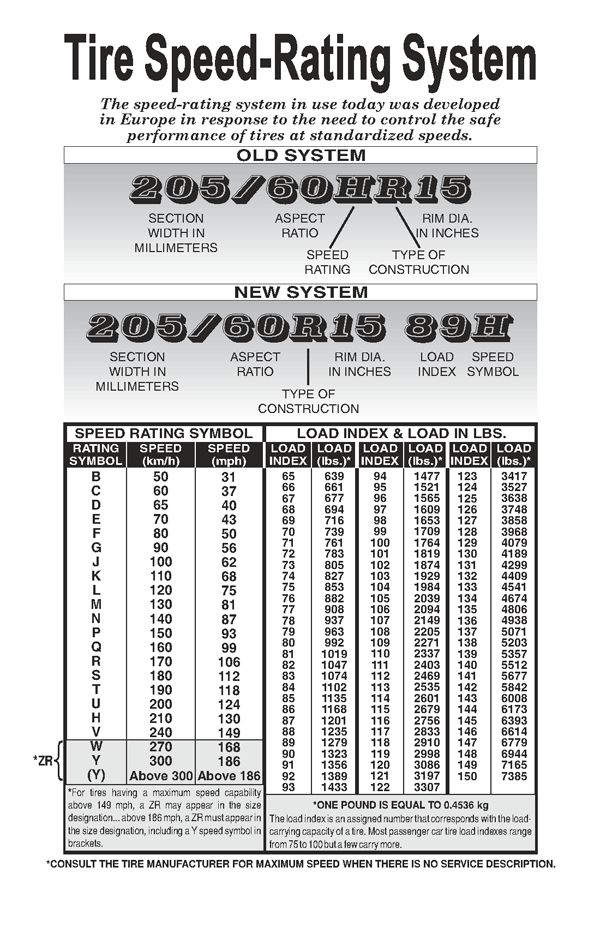 |
| Sidewall height | The sidewall height is represented as a percentage of the tire width. |
| Radial | This indicates the construction of the tire. |
| Diameter of the wheel | The diameter of the wheel that this tire will mount to, is 12 inches. |
Understanding how to read this tire size is just an initial phase. You also need to understand how to use them. Are 24 inches being suitable diameter for your quad? What type of length and width do you need for your quad?
Tire Diameter Breakdown:If you’re thinking of replacing all your tires, you’ll need to buy tires that fit your standard vehicle. Typical ATV tire diameters range from about 20″ for the smallest machines to about 30″ for more factory equipment.
Typically, ATVs fall into one of several categories.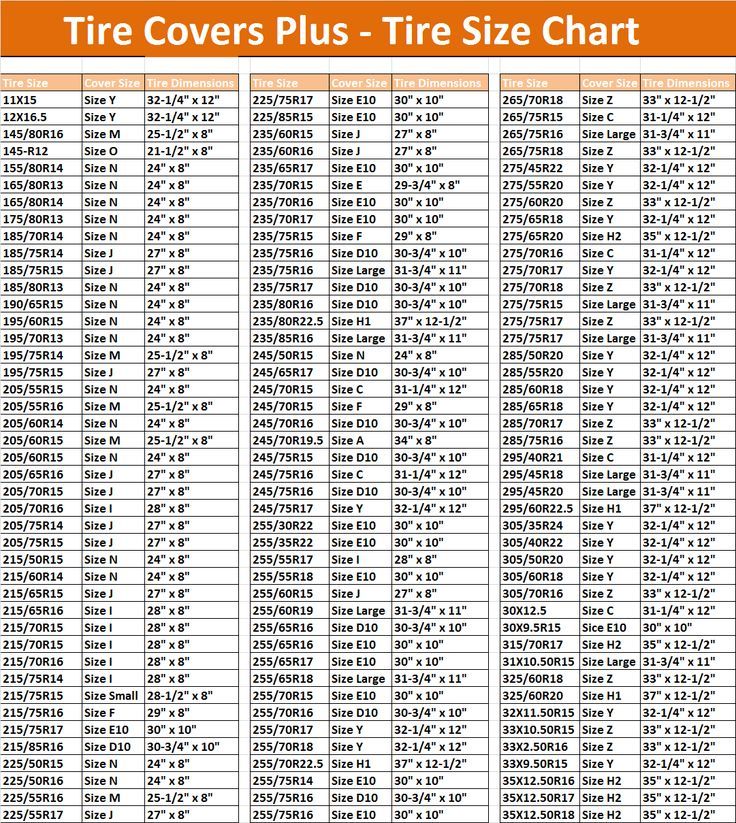
What is The Best Rim Size for Off-Roading?
Tire Width Breakdown:The width of the tire is easy to understand. Choosing the right tire width largely depends on your preferences and riding style. Wide tires provide a flatter tread pattern and better grip. Narrow tires give you more control. ATVs tend to have a wider rear tire than the front to get the most out of both tires.
Typical ATV rear tires are 10" to 11" wide and front tires 7" to 8" wide. However, fitting the tire width to your riding style isn't the only thing to consider. You also need to make sure that it physically fits your chosen wheel.
There are two main ways to make sure it works:

You need to make sure that the wheel diameter of the tire matches the actual wheel diameter. Most off-road wheels are typically 10 to 12 inches in diameter, which is convenient considering that most off-road tires are designed for these wheels.
This is a good size as it provides ample cushioning between the tread and rim of the tire for a smoother ride and better rim protection. Of course, we can get bigger wheels with bigger tires, but we’re getting ahead of ourselves.
What Tire Pressure for Off-Roading Is Suitable
Choose the Right Tires for ATV:Old tires are not needed. You should choose the tire size that is best for your ATV. After all, you go your own way and have your needs. We’re going to simplify our riding style into three main types.
You should choose the tire size that is best for your ATV. After all, you go your own way and have your needs. We’re going to simplify our riding style into three main types.
Who Makes Tracker ATV?
All-Purpose ATV Tires:If I can keep things simple and drive all these terrains without changing tires, I’d go with All-purpose tires. Anyway, this usually comes with a new ATV. If you choose to use these tires, keep the tread depth at least 0.5 inches. So, the tire will last for a while.
All-purpose tires are the most popular and most purchased 4-wheel vehicle tires. From muddy riverbeds to paved trails, you can experience the same performance on your rig. Surely the mud tires will beat them in the mud. But for casual riders, All-purpose tires are the best choice.
Off-Road ATV Tires:Off-road tires are very similar to All-purpose tires. The only real difference is that Off-road tires are made with a harder tread and are generally more durable. You must be able to handle off-road situations. Off-road tires are generally the more durable all-terrain tires because you can touch everything from snowy mountain roads to sandy forest trails.
The only real difference is that Off-road tires are made with a harder tread and are generally more durable. You must be able to handle off-road situations. Off-road tires are generally the more durable all-terrain tires because you can touch everything from snowy mountain roads to sandy forest trails.
Human hands usually make ATV moto crosses. The soil is loose, so you’ll need tires with solid lugs to help you around corners. However, an increased tread pattern is also required to improve traction when accelerating. The grip is very important when jumps and other obstacles can lead to injury.
Mud ATV Tires:These types of tires usually have a deeper hole than most other tires. Mud tires should provide traction in a worst-case scenario. Tires have large bumps to help them get out of mud or snow. They will guide you on dirtier terrain than off-road tires. Make sure you choose the right size for your wheel.
Sand tires are only needed if you plan to roll the dunes. By the way, great and worth a try. In general, the rear wheel is like an oar through the sand, and the front wheel is smooth except for a centre rib for steering.
Sand tires can be expensive and hard to justify as they are only really useful for dune bikes. You might be fine with your general-purpose tires, but you’ll get stuck and tired of crawling.
Street Tires:If you want UTV/ATV legalized, you need to install road tires. In most states, these DOT-approved tires are required before the ATV can be taken out on the road. Like regular car tires, they need periodic replacement to prevent excessive wear and tear. Asphalt is always rough on the tire tread, regardless of the vehicle, so it usually wears out the fastest.
Snow Tires:Snow removal with blades mounted on the rear of the ATV. Enlargement. Most mud and trail tires work better in snow.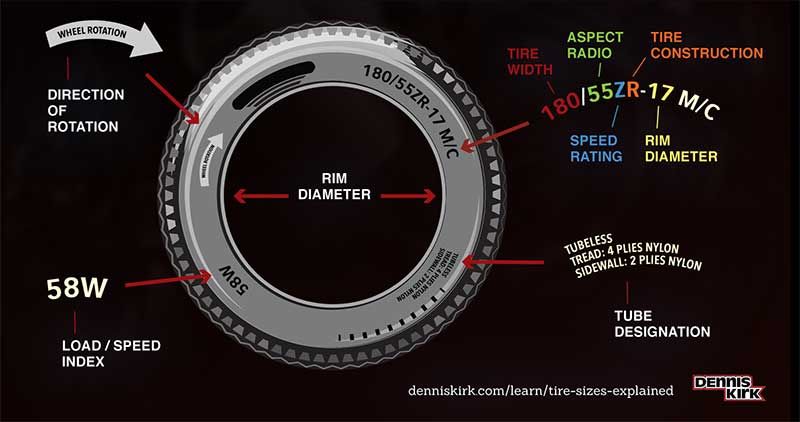 However, true ATV winter tires are specifically designed to improve traction in snow. There are two main designs for winter tires, both of which resemble a combination of other styles.
However, true ATV winter tires are specifically designed to improve traction in snow. There are two main designs for winter tires, both of which resemble a combination of other styles.
The first design is similar to a trail tire but with shorter lugs with a mud pitch. The second design sports a muddy or trail tire pattern with very thin lugs. Both styles have distinct advantages. The first design allows you to add more studs, especially if you need more traction on icy roads.
The second style works wonderfully on loose snow and is great for sports ATVs. Both designs have large tread gaps, allowing tire build-up to be easily removed.
How Much Do Off-Road Tires Cost? Regressive Analysis
Trail:This is arguably the most common tire, in part because it is very versatile and can handle most terrains and situations quite well. Besides, they tend to last quite a long time. Trail tires are also available in a variety of tread patterns. Some come with long side lugs, others with square lugs.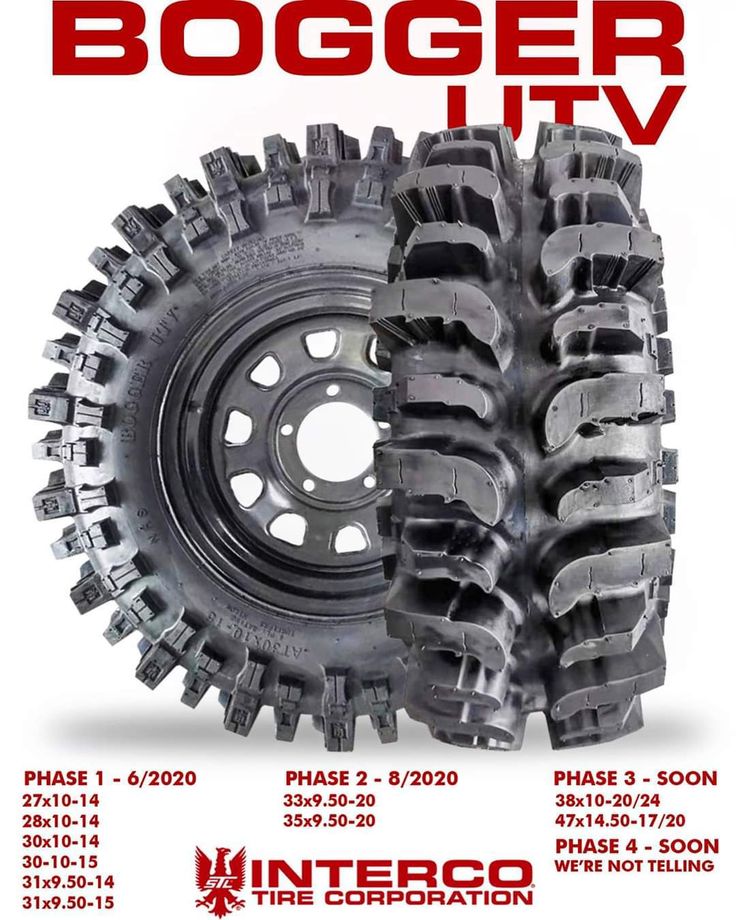
Trail tires have in common that the bumps are very close together, which creates a slightly larger contact patch. The tread depth of these tires is typically 1 inch to 1 inch. This tread depth, combined with a large contact patch, provides excellent grip to the trail tires for a smooth ride.
Facts related to ATV tires and tire size
Racing | All-Terrain | ||
Riding in mud holds no substitute and this is the basic tread pattern. | They are also called paddle tires as they look like paddles. | Racing tires hold specialty and are considered as best ones to work on sport ATV. | This is a weapon of choice in the world of ATV and side-by-side. |
ATV mud tires are all about to go forward in sloppy surfaces. | Fronts are normally smooth and have a couple of simple ribs. They are not good for anything except sand. | They hold special tread designs and compounds and have a flat profile. This thing intends them to run on medium to hard-packed terrain. | This category holds the designs which are favorable to one kind of terrain more than another. |
If you ride these mud tires in rocks or on hardpack terrain, then you will definitely pay the price for it. They are not too bad on other soft surfaces. | You can keep a pair of rear paddles mounted whenever you get the urge to ride the dunes. | These tires are probably the better choice in all-terrain type tires. | They have a little more tread depth with a bit more space between lugs. This thing is considered better for self-cleaning and gives better traction. |
| Pros (Wider than stock) | Cons (Wider than stock) |
| Increased concerning traction | More steering efforts |
| Better Acceleration | Increased stress on suspension components |
| Braking on some surfaces | Tire rub on some ATVs |
| (Narrower than stock) | (Narrower than stock) |
| Improved grip in soft terrains like mud and snow | Less grip on most hard surfaces and more tendency to follow ruts |
| Small Diameter | Large Diameter |
|---|---|
They reduce the center of gravity and ground clearance.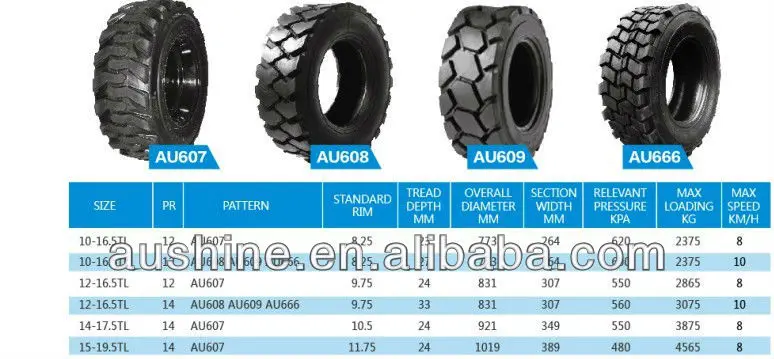 | They increase the center of gravity and ground clearance. |
| They reduce tip fins and provide a higher center of gravity on rough terrain. | Load on the transmission and brakes increases. |
| Acceleration is faster in this case and top speed is lower. | Acceleration is slower in this case and top speed is higher. |
If you don’t know yet, you might be shocked by the price of OHV tires. There are so many brands and types of tires to choose from; you can choose a price point before buying a tire.
Then limit yourself to considering tires in this price range. Choose the tire that best fits your ATV and riding style. If money isn’t really important to you, buy a few sets of special tires, and you’ll be ready for any terrain.
How to Read Standard Tire Size?Example: 26×8×12
Height | Diameter | |
In the above example, 26 is the overall height of the tire. | In the above example, 8 is the overall width of the tire. | In the above example, 12 is the overall diameter of the tire. |
It is related to height when the tire is mounted and inflated to recommended air pressure. | It is related to width when the tire is mounted and inflated to recommended air pressure. | It is related to the diameter when the tire will mount to. |
This means that from the above example, the tire must be 26 inches tall. | This means that from the above example, the tire must be 8 inches wide. | This means the form above example, the tire must be 12-inch in diameter. |
Example: 207/60R13
Aspect Ratio | Radial Construction | Diameter | |
From the above example, 207 is considered as the width of the tire in millimeters. | From the above example, 60 is the aspect ratio. | From the above example, R is the radial construction. | From the above example, 13 is the diameter of the wheel. |
It is related to the width when the tire is inflated and mounted to recommended air pressure. | Aspect ratio to the width of the tire is when it is inflated and mounted to recommended air pressure. This specifies the sidewall height. | R which is the radial construction indicates that the tire uses radial construction. | The diameter of the wheel indicates that the tire will mount to and from the above example, the wheel holds a 13-inch diameter. |
Also Read:
What to Wear During ATV Riding?
What is a UTV vs ATV?
How Much Does An ATV Cost? Complete Guide
ATV tires are listed in a set of three numbers which are separated by dashes. For example, we can consider 25 ×10-12 as tire size in which 25 is considered the tire’s height, 10 is the tire width, and the 3rd number, which is 12, is considered as wheel diameter.
If you want to determine the diameter of the wheel, measure the width of the bead area of the wheel, excluding the outer rim. Measure the center weld to the center of the tire bead area on both sides of the wheel if you want to determine the offset and width of the wheel.
It is a general rule that most vehicles tend to easily handle an increase in tire size one or two sizes larger than the stock.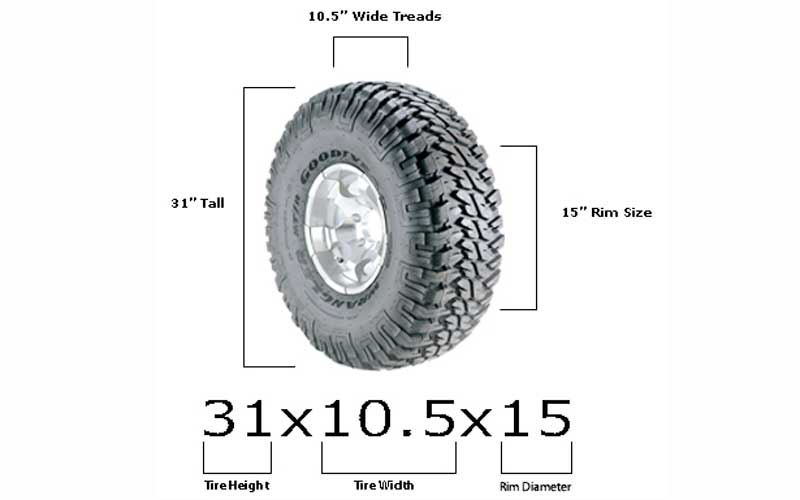
It will become noticeably harder to steer, but still, you can install the same width tires. If you don’t have a power steering, it is advisable not to attempt this.
Every ATM rim has an offset that consists of two numbers. The first number is the measurement from inside lip to rim to the center of rim where hub and rim meet. The second number is the measurement from the hub to the outside lip of the rim.
Smaller-width tires are adjusted on the front side of the ATV as they have less surface contact due to their smaller size. There is less tire touching the ground at any given time. The steering effort is reduced so side-by-side becomes easier to maneuver.
ATV tires are wider in the rear as they increase traction and stability. It enhances the safety and overall performance of the vehicle.
Surya
This is Surya. I am an experienced off-roader. I have been off-roading for many years across several terrains. I am passionate about 4×4 driving and want to share my knowledge and experience with others.
My goal is to provide you with the most comprehensive and unbiased information about off-roading.
I curated this article through my personal experience and expertise, and I hope it helps you with what you are looking for.
05/17/2018
The numbers written on the side of the rubber tire can tell the owner of the ATV everything that interests him. And if you are for some If you don't know what these mysterious numbers mean, then you can be mistaken when choosing the next set of tires. But tires directly determine whether it will go technique further or not. So, in this article you will close all the questions on about the decoding of size ATV tire .
All tires have their own basic parameters - this is the width, height and diameter.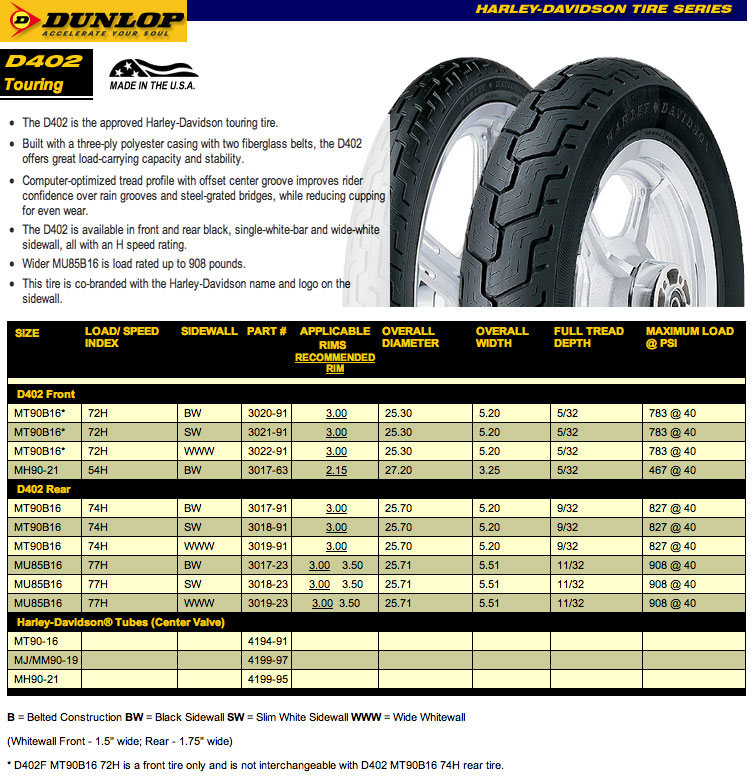 The value of these parameters is mainly measured in inches. Exists two units:
The value of these parameters is mainly measured in inches. Exists two units:
1) If you have ATV, then this is for you. English version is the most common number system that is used when determination of tire dimensions on ATVs. All measurements here are in inches. (1 inch equals 2.54 cm). For example, the size indicated in English classification looks like this - 25x8x12 . Let's take a closer look at the meaning of each digit:
- The first digit 25 shows the height of the tire in inches;
- The second digit 8 indicates the width of the tire in inches;
- The last, third digit 12 indicates the diameter of the wheel disk, it is also measured in inches. Disc diameter on each ATV can be different. Therefore, be careful before you buy tires for ATV, see what regular disks are installed on your vehicle.
And a very important point worth noting. Often our customers ask themselves: “If I have a tire size of 20x10x10, can I put instead of them 20x11x10? The answer is yes. First, you can put rubber on regular wheels with a size exceeding 1 inch in height and width. Secondly, if you want tires even wider, then for this you will need to buy other disks. But again, there are limitations. On discs of other diameters, you can install rubber, the largest is only 2 inches in height and width.
First, you can put rubber on regular wheels with a size exceeding 1 inch in height and width. Secondly, if you want tires even wider, then for this you will need to buy other disks. But again, there are limitations. On discs of other diameters, you can install rubber, the largest is only 2 inches in height and width.
These two rules must be strictly observed, otherwise, if you try to put tires of an unacceptably large size, this may adversely affect on a quad bike. After all, the rubber will be larger and, accordingly, heavier, which does not fit the technical parameters of the ATV. In production ATVs take into account all the characteristics, so manufacturers of ATV equipment I don't recommend using larger tires at all. But if you do decided to increase the size of tires, call our toll-free number, we we will help.
2) Also there is another version - metric . Here the dimensions are indicated in percentage and millimeters. For example, size specified according to the metric classification - 205/80 Rx12 . Such designations are usually used on automobile tires. Let's see what's what:
Such designations are usually used on automobile tires. Let's see what's what:
- The first digit of 205 shows the total tire width in millimeters. Converting this value to inches, we will just get the number 8 (in the English version is 8 inches wide).
- The second digit 80 indicates the ratio of the height of the tire to its width, measured as a percentage. After doing some mathematical manipulations, we get the number 25 (in the English version, the height is equal to 25 inches).
- The number 12, as in the English version, shows the size disk in inches.
- Well, the letter R means that our tire is radial.
The most important thing to remember from the article is that it is not recommended to install tires of huge sizes that do not correspond to the parameters your ATV . If you want to change the tires on your vehicle, give us a call. we will help.
May 31, 2017, 10:15 am
An ATV is perhaps one of the most versatile vehicles. On it you can go hunting or fishing, take part in high-speed races or just go with your family to nature. Depending on the purpose for which the ATV will be used, a suitable model is selected.
On it you can go hunting or fishing, take part in high-speed races or just go with your family to nature. Depending on the purpose for which the ATV will be used, a suitable model is selected.
An important factor is the choice of rubber, since the efficiency and safety of using an ATV depends on it.
When choosing tires for ATVs, you should be guided not only by personal needs, but also take into account your driving style, and also in what conditions the “iron horse” will be used. All tires for an ATV are divided into two types - diagonal and radial. Each of them is designed for driving in a certain area. Bias tires are the most popular, as they do an excellent job of overcoming fords, mud and swamps. Radials are designed for high speed driving on hard surfaces, so they are usually used on racing models.
One of the most important details when choosing a quad tire is the tread pattern. And this is far from a design "trick", as many believe.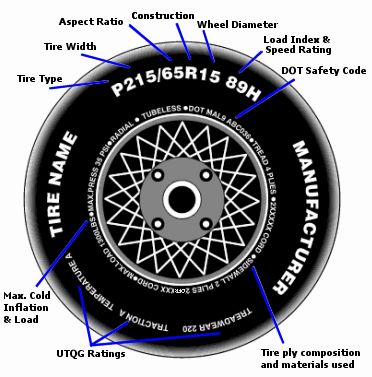 It depends on him in what conditions it will be possible to use the ATV. Based on this, all tires are divided into the following types:
It depends on him in what conditions it will be possible to use the ATV. Based on this, all tires are divided into the following types:
for sand - have a bladed tread that provides excellent grip on sandy terrain;
Mud - equipped with deep herringbone tread to avoid towing when hit in mud;
sporty - have a flat surface with small protrusions to guarantee maximum stability on a hard road surface;
universal - their tread has a small pattern that provides excellent grip on any terrain;
winter - have a special tread pattern, and can also be additionally equipped with spikes and chains.
Quad tires are usually used in two systems of sizes - English and metric. English looks like this: 25x8-12, where 25 is the height of the tire in inches, 8 is its width, 12 is the diameter of the disk.
For us, the metric system is more convenient, which has the following form: 205 / 80R12, in this case, the dimensions are in millimeters.